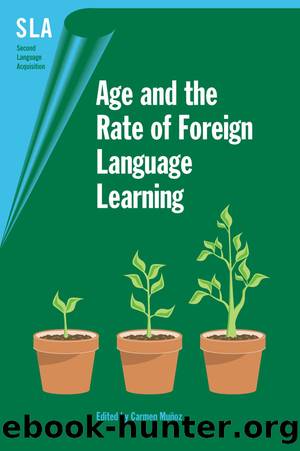Age and the Rate of Foreign Language Learning by Muñoz Carmen;

Author:Muñoz, Carmen;
Language: eng
Format: epub
Publisher: Multilingual Matters
Published: 2006-08-15T00:00:00+00:00
Rate and ultimate attainment
The distinction between rate of acquisition and ultimate attainment has been proven necessary in studies on the role of age in L2 acquisition. Since the early years of the decade of the 1960s, the question of whether children or adults are more successful language learners has generated a wealth of research, a question still relevant today. The results of studies in naturalistic settings suggest that age of initial exposure is a determining factor in predicting ultimate language proficiency. In other words, the younger children are first exposed to the L2, the more chances they have of coming to be considered native, or near native L2 speakers (see DeKeyser & Larson-Hall, 2005, for a review of the relevant studies). These findings corroborate the Critical Period Hypothesis (CPH) (Lenneberg, 1967), which, in the strong version, states that during the years leading up to puberty children can acquire an L2 more easily and also achieve native-like competence. After puberty, acquisition becomes more difficult and native-like competence impossible. The strong version of the CPH, however, can no longer be sustained in the face of cases in which learners first exposed to the L2 in adulthood become indistinguishable from native speakers (Bongaerts et al., 1997; Ioup et al., 1994), or, on the contrary, when young children fail to achieve native-like control (Hyltenstam & Abrahamsson, 2000; Thompson, 1991). The hypothesisâ weaker version proposes instead a sensitive period during which L2 acquisition is simply more efficient.
Different learning mechanisms used by adults and children have been advanced as an explanation for the decline in ultimate attainment. The crux of the idea is that children use domain-specific procedures, while adults rely on general learning abilities (Bley-Vroman, 1988). In other terms, children acquire an L2 for the most part implicitly, whereas adults learn an L2 by means of explicit and declarative knowledge (DeKeyser, 2000; Harley & Hart, 1997). In fact, the explanation is consistent with the results of studies in which participants are exposed to the L2 for short periods of time, calculated as about ten months, in which adults are shown to have an advantage over children in the form of an initially faster rate of acquisition (Bialystok, 1997; Snow & Hoefnagel-Höhle, 1978). Under this view, adults employ explicit learning mechanisms that provide them with a head start, but that are less effective in the long run. Children, on the other hand, benefit from implicit learning, which is initially slower but more efficient in the long run. The empirical evidence necessary to support this view is however as yet unavailable.
The evidence to date for instructed language acquisition is consistent with the finding for naturalistic studies as regards the initial faster rate of adults and older children. No current study, however, with the foreign language classroom as learning context has shown that young children catch up with adults and older children in the long run. Singleton (1989) argues that the discrepancies result from variation in amount of exposure in the two contexts: to date, studies of the
Download
This site does not store any files on its server. We only index and link to content provided by other sites. Please contact the content providers to delete copyright contents if any and email us, we'll remove relevant links or contents immediately.
Cecilia; Or, Memoirs of an Heiress — Volume 1 by Fanny Burney(32091)
Cecilia; Or, Memoirs of an Heiress — Volume 3 by Fanny Burney(31481)
Cecilia; Or, Memoirs of an Heiress — Volume 2 by Fanny Burney(31435)
The Lost Art of Listening by Michael P. Nichols(7190)
We Need to Talk by Celeste Headlee(5425)
Asking the Right Questions: A Guide to Critical Thinking by M. Neil Browne & Stuart M. Keeley(5387)
On Writing A Memoir of the Craft by Stephen King(4684)
Dialogue by Robert McKee(4184)
Pre-Suasion: A Revolutionary Way to Influence and Persuade by Robert Cialdini(3999)
I Have Something to Say: Mastering the Art of Public Speaking in an Age of Disconnection by John Bowe(3786)
Elements of Style 2017 by Richard De A'Morelli(3241)
The Book of Human Emotions by Tiffany Watt Smith(3154)
Fluent Forever: How to Learn Any Language Fast and Never Forget It by Gabriel Wyner(2925)
Name Book, The: Over 10,000 Names--Their Meanings, Origins, and Spiritual Significance by Astoria Dorothy(2852)
Good Humor, Bad Taste: A Sociology of the Joke by Kuipers Giselinde(2830)
Why I Write by George Orwell(2788)
The Grammaring Guide to English Grammar with Exercises by Péter Simon(2650)
The Art Of Deception by Kevin Mitnick(2633)
Ancient Worlds by Michael Scott(2515)
